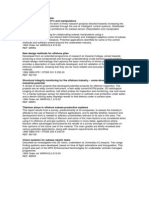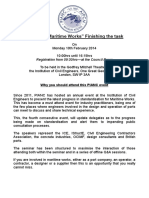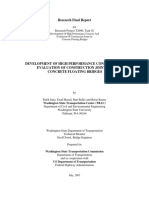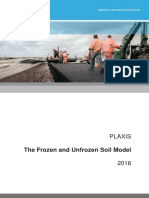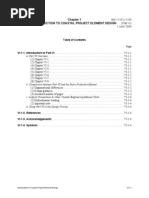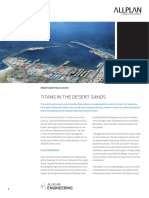Advanced Structural Analysis Syllabus
Uploaded by
kalpanaadhiAdvanced Structural Analysis Syllabus
Uploaded by
kalpanaadhiNPTEL Syllabus
Advanced Structural Analysis Video course
COURSE OUTLINE This course mainly deals with matrix analysis of structures. It begins with a review of the basic concepts of structural analysis and matrix algebra, and shows how the latter provides an excellent mathematical framework for the former. This is followed by detailed descriptions, and demonstrations through many examples, of how matrix methods can be applied to linear static analysis of skeletal structures (plane and space trusses; beams and grids; plane and space frames) by the stiffness method, and also the flexibility method.
NPTEL
http://nptel.iitm.ac.in
Civil Engineering
Also, it is shown how simple structures can be conveniently solved using a reduced stiffness formulation, involving far less Pre-requisites: computational effort. 1. Structural Analysis. Finally, the analysis of elastic instability and second-order response is discussed. Additional Reading: The main objective is to enable the student to have a good grasp of all the fundamental issues in these advanced topics in structural analysis, besides enjoying the learning process, and developing analytical and intuitive skills. 1. Review topics on Structural Analysis and Linear Algebra.
This course is also expected to enable a good understanding Coordinators: of how standard software packages (routinely used for frame analysis in design offices) operate. Prof. Devdas Menon Department of Civil Moreover, the student will be well prepared to explore and EngineeringIIT Madras understand further topics like Finite Element Analysis. COURSE DETAIL
Sl. No.
Topic
No. of Hours
Review of basic concepts in structural analysis:
structure (structural elements, joints and supports, stability, rigidity and static indeterminacy, kinematic indeterminacy); loads (direct actions, indirect loading); response (equilibrium, compatibility, force-displacement relations); levels of analysis; analysis of statically determinate structures (trusses, beams, frames); applications of principle of virtual work and displacement-based and force-based energy principles; deriving stiffness and flexibility coefficients.
Review of analysis of indeterminate structures: Force methods: Statically indeterminate structures (method of consistent deformations; theorem of least work). Displacement Methods: Kinematically indeterminate structures (slope-deflection method; moment distribution method).
Matrix concepts and Matrix analysis of structures: Matrix; vector; basic matrix operations; rank; solution of linear simultaneous equations; eigenvalues and eigenvectors. Introduction; coordinate systems; displacement and force transformation matrices; Contra-gradient principle; element and structure stiffness matrices; Element and structure flexibility matrices; equivalent joint loads; stiffness and flexibility approaches.
Matrix analysis of structures with axial elements: Introduction: Axial stiffness and flexibility; stiffness matrices for an axial element (two dof), plane truss element (four dof) and space truss element (six dof); One-dimensional axial structures: Analysis by conventional stiffness method (two dof per element) and reduced element stiffness method (single dof); Analysis by flexibility method; Plane trusses: Analysis by conventional stiffness method (four dof per element) and reduced element stiffness method (single dof); Analysis by flexibility method; Space trusses: Analysis by conventional stiffness method (six dof per element) and reduced element stiffness method (single dof).
Matrix analysis of beams and grids: Conventional stiffness method for beams: Beam element stiffness (four dof); generation of stiffness matrix for continuous beam; dealing with internal hinges, hinged and guided-fixed end supports; accounting for shear deformations; Reduced stiffness method for beams: Beam element stiffness (two dof); dealing with moment releases, hinged and guided-fixed end supports; Flexibility method for fixed and continuous beams: Force transformation matrix; element flexibility matrix; solution procedure
10
flexibility matrix; solution procedure (including support movements); Stiffness method for grids: Introduction; torsional stiffness of grid element and advantage of torsion release; analysis by conventional stiffness method using grid element with six dof; analysis by reduced stiffness method (three dof per element);
Matrix analysis of plane and space frames: Conventional stiffness method for plane frames: Element stiffness (six dof); generation of structure stiffness matrix and solution procedure; dealing with internal hinges and various end conditions; Reduced stiffness method for plane frames: Element stiffness (three dof); ignoring axial deformations; dealing with moment releases, hinged and guidedfixed end supports; Flexibility method for plane frames: Force transformation matrix; element flexibility matrix; solution procedure (including support movements); Ignoring axial deformations; Stiffness method for space frames: Introduction; element stiffness matrix of space frame element with 12 dof and 6 dof; coordinate transformations; analysis by reduced stiffness method (six dof per element);
Analysis of elastic instability and second-order effects: Effects of axial force on flexural stiffness: Review of buckling of ideal columns; flexural behaviour and stiffness
measures for beam-columns - braced and unbraced, under axial compression; Solution by slope deflection method: Slope deflection equations for prismatic beam columns using stability functions; modifications for pinned and guided-fixed-end conditions; fixedend moments in beam-columns; Solution by matrix method: Stiffness matrix for prismatic beamcolumn element; estimation of critical elastic buckling loads; second-order analysis;
Total References:
43
1. Devdas Menon, "Advanced Structural Analysis", Narosa Publishing House, 2009. 2. Asslam Kassimali, "Matrix Analysis of Structures", Brooks/Cole Publishing Co., USA, 1999. 3. Amin Ghali, Adam M Neville and Tom G Brown, "Structural Analysis: A Unified Classical and Matrix Approach", Sixth Edition, 2007, Chapman & Hall. 4. Devdas Menon, "Structural Analysis", Narosa Publishing House, 2008.
A joint venture by IISc and IITs, funded by MHRD, Govt of India http://nptel.iitm.ac.in
You might also like
- Chapter 15 Business Studies Grade 12 Notes On Presentation and Data ResponseNo ratings yetChapter 15 Business Studies Grade 12 Notes On Presentation and Data Response8 pages
- Zlib - Pub Human Robot Interaction Control Using Reinforcement LearningNo ratings yetZlib - Pub Human Robot Interaction Control Using Reinforcement Learning289 pages
- Effect of Load Eccentricity and Stress Level On Monopile Support For Offshore TurbinesNo ratings yetEffect of Load Eccentricity and Stress Level On Monopile Support For Offshore Turbines9 pages
- Dolphins: Hamburg-Finkenwerder Berthing Basin For Large VesselsNo ratings yetDolphins: Hamburg-Finkenwerder Berthing Basin For Large Vessels12 pages
- Damage Mechanics in Metal Forming: Advanced Modeling and Numerical SimulationFrom EverandDamage Mechanics in Metal Forming: Advanced Modeling and Numerical Simulation4/5 (1)
- Strandhill Beach - Coastal Erosion Studyc - Final - Draft67% (3)Strandhill Beach - Coastal Erosion Studyc - Final - Draft45 pages
- Basic Image Processing For Robotics ManualNo ratings yetBasic Image Processing For Robotics Manual103 pages
- BS 6349: "Maritime Works" Finishing The Task: Registration From 09:30hrs-At The Council RoomNo ratings yetBS 6349: "Maritime Works" Finishing The Task: Registration From 09:30hrs-At The Council Room9 pages
- Waves and Wave Forces On Coastal and Ocean Structures: Robert T. Hudspeth0% (1)Waves and Wave Forces On Coastal and Ocean Structures: Robert T. Hudspeth954 pages
- 3113.PLAXIS - The Frozen and Unfrozen Soil Model (2016)No ratings yet3113.PLAXIS - The Frozen and Unfrozen Soil Model (2016)36 pages
- Concrete Road Design and Construction - Update (2007-2009)No ratings yetConcrete Road Design and Construction - Update (2007-2009)48 pages
- Shaft Capacity of Pipe Pile in Sand - t02-093No ratings yetShaft Capacity of Pipe Pile in Sand - t02-09310 pages
- Earthquake Design of Rectangular Underground StructuresNo ratings yetEarthquake Design of Rectangular Underground Structures8 pages
- Comparative Analysis and Design of RCC Circular and Rectangular Shape Water Tank Resting On GroundNo ratings yetComparative Analysis and Design of RCC Circular and Rectangular Shape Water Tank Resting On Ground3 pages
- Static Analysis of Jacketed Type OffshorNo ratings yetStatic Analysis of Jacketed Type Offshor7 pages
- Marine Fender - Ocean Guard Netless Foam-Filled Marine Fender High Capacity100% (2)Marine Fender - Ocean Guard Netless Foam-Filled Marine Fender High Capacity1 page
- Driven Pile Design Methods in Weak Rock: September 2017No ratings yetDriven Pile Design Methods in Weak Rock: September 20177 pages
- WK 16 Revision Offshore & Subsea Structures LNB40702 LNB30602No ratings yetWK 16 Revision Offshore & Subsea Structures LNB40702 LNB3060271 pages
- Numerical Analysis of The Reinforced StoNo ratings yetNumerical Analysis of The Reinforced Sto8 pages
- PIANC WG 40: Guidelines For The Design and Construction of Berm BreakwatersNo ratings yetPIANC WG 40: Guidelines For The Design and Construction of Berm Breakwaters14 pages
- Wave Reflection by Submerged Vertical and Semicircular Breakwaters100% (1)Wave Reflection by Submerged Vertical and Semicircular Breakwaters8 pages
- On The Delayed Failure of Geotechnical Structures in Low Permeability GroundNo ratings yetOn The Delayed Failure of Geotechnical Structures in Low Permeability Ground222 pages
- Thesis-Soil-Structure Interaction For Non-Slender - Large Diamter Offshore MonopileNo ratings yetThesis-Soil-Structure Interaction For Non-Slender - Large Diamter Offshore Monopile57 pages
- PT55 Article Seismic Considerations For New Quay CranesNo ratings yetPT55 Article Seismic Considerations For New Quay Cranes3 pages
- Estimating Nearshore Conditions For Irregular Waves: Coastal Engineering Research CenterNo ratings yetEstimating Nearshore Conditions For Irregular Waves: Coastal Engineering Research Center50 pages
- A Case Study of The New Breakwater of The Port of GenovaNo ratings yetA Case Study of The New Breakwater of The Port of Genova43 pages
- (2017) A Frame Work To Assess Structural Integrity of Ageing Offshore Jacket Structures For Life ExtensionNo ratings yet(2017) A Frame Work To Assess Structural Integrity of Ageing Offshore Jacket Structures For Life Extension23 pages
- Installation Effects Due To Pile Surging in Sand100% (3)Installation Effects Due To Pile Surging in Sand214 pages
- Dynamic Soil-Structure Interaction Issues of Offshore Wind Turbines PDFNo ratings yetDynamic Soil-Structure Interaction Issues of Offshore Wind Turbines PDF8 pages
- Porirua Harbour and Catchment - Literature Review ReportNo ratings yetPorirua Harbour and Catchment - Literature Review Report101 pages
- Knjiga Composite Steel Concrete Buildings100% (2)Knjiga Composite Steel Concrete Buildings204 pages
- Ultimate/Accidental Limit State Analysis and DesignNo ratings yetUltimate/Accidental Limit State Analysis and Design49 pages
- Design of Marine Facilities Engineering For Port and Harbor Structures John W. Gaythwaite Ebook All Chapters PDF100% (2)Design of Marine Facilities Engineering For Port and Harbor Structures John W. Gaythwaite Ebook All Chapters PDF62 pages
- Titans in The Desert Sands: Allplan Engineering in PracticeNo ratings yetTitans in The Desert Sands: Allplan Engineering in Practice5 pages
- AUSTROADS - Bridge Manual - Part 2 - Materials - AGBT02-09 PDFNo ratings yetAUSTROADS - Bridge Manual - Part 2 - Materials - AGBT02-09 PDF144 pages
- [FREE PDF sample] Quay Walls Second Edition J.G. De Gijt ebooks100% (18)[FREE PDF sample] Quay Walls Second Edition J.G. De Gijt ebooks71 pages
- Book (Assessment of Soil Liquefaction Safety..)No ratings yetBook (Assessment of Soil Liquefaction Safety..)380 pages
- Software Simulation of Environmental Loads For Offshore Structures Primary DraftNo ratings yetSoftware Simulation of Environmental Loads For Offshore Structures Primary Draft12 pages
- A Catalogue of Details on Pre-Contract Schedules: Surgical Eye Centre of Excellence - KathFrom EverandA Catalogue of Details on Pre-Contract Schedules: Surgical Eye Centre of Excellence - KathNo ratings yet
- Methodologies for Seismic Safety Evaluation of Existing Nuclear InstallationsFrom EverandMethodologies for Seismic Safety Evaluation of Existing Nuclear InstallationsNo ratings yet
- Harvesting Freedom: The Life of a Migrant Worker in CanadaFrom EverandHarvesting Freedom: The Life of a Migrant Worker in CanadaNo ratings yet
- Join Yoursmahboob Official Youtube ChannelNo ratings yetJoin Yoursmahboob Official Youtube Channel975 pages
- Design Manual For Is 800 - 2007 - Compression MembersNo ratings yetDesign Manual For Is 800 - 2007 - Compression Members6 pages
- Is 875 (Part 3) - 2015 Annex A As Per AmendmentNo ratings yetIs 875 (Part 3) - 2015 Annex A As Per Amendment1 page
- SP6 - 1 Gauge Distance in Legs of AnglesNo ratings yetSP6 - 1 Gauge Distance in Legs of Angles1 page
- Effect of Water Table On Allowable Bearing Capacity100% (1)Effect of Water Table On Allowable Bearing Capacity4 pages
- Photovoltaics Fixed Structures Mecasolar CatalogNo ratings yetPhotovoltaics Fixed Structures Mecasolar Catalog4 pages
- Human Bingo: Getting To Know Each OtherNo ratings yetHuman Bingo: Getting To Know Each Other42 pages
- LG LM v605n v60 Thinq 5g Manual OriginalNo ratings yetLG LM v605n v60 Thinq 5g Manual Original247 pages
- First Floor Drainage System: D E F G H I J K L A B CNo ratings yetFirst Floor Drainage System: D E F G H I J K L A B C1 page
- Quiz Contest: Bharati Vidyapeeth Institute of Technology, KhargharNo ratings yetQuiz Contest: Bharati Vidyapeeth Institute of Technology, Kharghar4 pages
- Fm-200 Total Flood Fire Suppression Systems: Design, Installation, and Maintenance Manual67% (3)Fm-200 Total Flood Fire Suppression Systems: Design, Installation, and Maintenance Manual170 pages
- High-Level Semantic Feature Detection: A New Perspective For Pedestrian DetectionNo ratings yetHigh-Level Semantic Feature Detection: A New Perspective For Pedestrian Detection10 pages
- Assignment Format Case Study - Strategic ManagementNo ratings yetAssignment Format Case Study - Strategic Management4 pages
- Lecture 1 and 2: Understanding The Corporate EnvironmentNo ratings yetLecture 1 and 2: Understanding The Corporate Environment19 pages
- Oca Java Se 8 Exam Chapter 2 Operators StatementsNo ratings yetOca Java Se 8 Exam Chapter 2 Operators Statements63 pages
- Team Evega 2.0-Design Report: I. Improvised Design After The Virtuals RoundNo ratings yetTeam Evega 2.0-Design Report: I. Improvised Design After The Virtuals Round7 pages
- Fundamentals of Networks - Lab - ManualNo ratings yetFundamentals of Networks - Lab - Manual36 pages
- Data Sheet - NAD T 763 AV Surround Sound ReceiverNo ratings yetData Sheet - NAD T 763 AV Surround Sound Receiver4 pages
- 03 Lomozik Creep-Resisting Structural Steels For The Power Industry-The Past and The Present TimeNo ratings yet03 Lomozik Creep-Resisting Structural Steels For The Power Industry-The Past and The Present Time8 pages
- Chapter 15 Business Studies Grade 12 Notes On Presentation and Data ResponseChapter 15 Business Studies Grade 12 Notes On Presentation and Data Response
- Zlib - Pub Human Robot Interaction Control Using Reinforcement LearningZlib - Pub Human Robot Interaction Control Using Reinforcement Learning
- Effect of Load Eccentricity and Stress Level On Monopile Support For Offshore TurbinesEffect of Load Eccentricity and Stress Level On Monopile Support For Offshore Turbines
- Dolphins: Hamburg-Finkenwerder Berthing Basin For Large VesselsDolphins: Hamburg-Finkenwerder Berthing Basin For Large Vessels
- Damage Mechanics in Metal Forming: Advanced Modeling and Numerical SimulationFrom EverandDamage Mechanics in Metal Forming: Advanced Modeling and Numerical Simulation
- Discrete Element Method to Model 3D Continuous MaterialsFrom EverandDiscrete Element Method to Model 3D Continuous Materials
- Strandhill Beach - Coastal Erosion Studyc - Final - DraftStrandhill Beach - Coastal Erosion Studyc - Final - Draft
- BS 6349: "Maritime Works" Finishing The Task: Registration From 09:30hrs-At The Council RoomBS 6349: "Maritime Works" Finishing The Task: Registration From 09:30hrs-At The Council Room
- Waves and Wave Forces On Coastal and Ocean Structures: Robert T. HudspethWaves and Wave Forces On Coastal and Ocean Structures: Robert T. Hudspeth
- 3113.PLAXIS - The Frozen and Unfrozen Soil Model (2016)3113.PLAXIS - The Frozen and Unfrozen Soil Model (2016)
- Concrete Road Design and Construction - Update (2007-2009)Concrete Road Design and Construction - Update (2007-2009)
- Earthquake Design of Rectangular Underground StructuresEarthquake Design of Rectangular Underground Structures
- Comparative Analysis and Design of RCC Circular and Rectangular Shape Water Tank Resting On GroundComparative Analysis and Design of RCC Circular and Rectangular Shape Water Tank Resting On Ground
- Marine Fender - Ocean Guard Netless Foam-Filled Marine Fender High CapacityMarine Fender - Ocean Guard Netless Foam-Filled Marine Fender High Capacity
- Driven Pile Design Methods in Weak Rock: September 2017Driven Pile Design Methods in Weak Rock: September 2017
- WK 16 Revision Offshore & Subsea Structures LNB40702 LNB30602WK 16 Revision Offshore & Subsea Structures LNB40702 LNB30602
- PIANC WG 40: Guidelines For The Design and Construction of Berm BreakwatersPIANC WG 40: Guidelines For The Design and Construction of Berm Breakwaters
- Wave Reflection by Submerged Vertical and Semicircular BreakwatersWave Reflection by Submerged Vertical and Semicircular Breakwaters
- On The Delayed Failure of Geotechnical Structures in Low Permeability GroundOn The Delayed Failure of Geotechnical Structures in Low Permeability Ground
- Thesis-Soil-Structure Interaction For Non-Slender - Large Diamter Offshore MonopileThesis-Soil-Structure Interaction For Non-Slender - Large Diamter Offshore Monopile
- PT55 Article Seismic Considerations For New Quay CranesPT55 Article Seismic Considerations For New Quay Cranes
- Estimating Nearshore Conditions For Irregular Waves: Coastal Engineering Research CenterEstimating Nearshore Conditions For Irregular Waves: Coastal Engineering Research Center
- A Case Study of The New Breakwater of The Port of GenovaA Case Study of The New Breakwater of The Port of Genova
- (2017) A Frame Work To Assess Structural Integrity of Ageing Offshore Jacket Structures For Life Extension(2017) A Frame Work To Assess Structural Integrity of Ageing Offshore Jacket Structures For Life Extension
- Dynamic Soil-Structure Interaction Issues of Offshore Wind Turbines PDFDynamic Soil-Structure Interaction Issues of Offshore Wind Turbines PDF
- Porirua Harbour and Catchment - Literature Review ReportPorirua Harbour and Catchment - Literature Review Report
- Ultimate/Accidental Limit State Analysis and DesignUltimate/Accidental Limit State Analysis and Design
- Design of Marine Facilities Engineering For Port and Harbor Structures John W. Gaythwaite Ebook All Chapters PDFDesign of Marine Facilities Engineering For Port and Harbor Structures John W. Gaythwaite Ebook All Chapters PDF
- Titans in The Desert Sands: Allplan Engineering in PracticeTitans in The Desert Sands: Allplan Engineering in Practice
- AUSTROADS - Bridge Manual - Part 2 - Materials - AGBT02-09 PDFAUSTROADS - Bridge Manual - Part 2 - Materials - AGBT02-09 PDF
- [FREE PDF sample] Quay Walls Second Edition J.G. De Gijt ebooks[FREE PDF sample] Quay Walls Second Edition J.G. De Gijt ebooks
- Software Simulation of Environmental Loads For Offshore Structures Primary DraftSoftware Simulation of Environmental Loads For Offshore Structures Primary Draft
- A Catalogue of Details on Pre-Contract Schedules: Surgical Eye Centre of Excellence - KathFrom EverandA Catalogue of Details on Pre-Contract Schedules: Surgical Eye Centre of Excellence - Kath
- Methodologies for Seismic Safety Evaluation of Existing Nuclear InstallationsFrom EverandMethodologies for Seismic Safety Evaluation of Existing Nuclear Installations
- Harvesting Freedom: The Life of a Migrant Worker in CanadaFrom EverandHarvesting Freedom: The Life of a Migrant Worker in Canada
- Design Manual For Is 800 - 2007 - Compression MembersDesign Manual For Is 800 - 2007 - Compression Members
- Effect of Water Table On Allowable Bearing CapacityEffect of Water Table On Allowable Bearing Capacity
- First Floor Drainage System: D E F G H I J K L A B CFirst Floor Drainage System: D E F G H I J K L A B C
- Quiz Contest: Bharati Vidyapeeth Institute of Technology, KhargharQuiz Contest: Bharati Vidyapeeth Institute of Technology, Kharghar
- Fm-200 Total Flood Fire Suppression Systems: Design, Installation, and Maintenance ManualFm-200 Total Flood Fire Suppression Systems: Design, Installation, and Maintenance Manual
- High-Level Semantic Feature Detection: A New Perspective For Pedestrian DetectionHigh-Level Semantic Feature Detection: A New Perspective For Pedestrian Detection
- Assignment Format Case Study - Strategic ManagementAssignment Format Case Study - Strategic Management
- Lecture 1 and 2: Understanding The Corporate EnvironmentLecture 1 and 2: Understanding The Corporate Environment
- Team Evega 2.0-Design Report: I. Improvised Design After The Virtuals RoundTeam Evega 2.0-Design Report: I. Improvised Design After The Virtuals Round
- 03 Lomozik Creep-Resisting Structural Steels For The Power Industry-The Past and The Present Time03 Lomozik Creep-Resisting Structural Steels For The Power Industry-The Past and The Present Time

